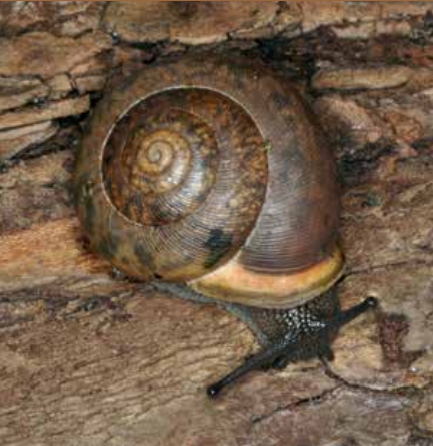Hidden world of snails in Manhattan

When most people think of Kansas wildlife, they picture bison, prairie dogs or songbirds. But beneath the leaf litter, around garden stones and in the moist corners of Manhattan's yards and woodlands lives a diverse and ecologically important group of creatures: land snails.
A Surprisingly Diverse Community
Kansas is home to approximately 67 species of snails and three species of slugs, making the Sunflower State far more diverse in gastropod life than most residents realize. Manhattan, situated in the transition zone between the eastern deciduous forests and the central grasslands, provides ideal habitat for many of these species.
These mollusks range dramatically in size and appearance. The smallest, like Punctum minutissimum (Small Spot), measure just 1 to 1.5 millimeters, while larger species can exceed 20 millimeters. Some are delicate spirals barely visible to the naked eye, while others, like the Whitewashed Rabdotus with its distinctive pale shell, are unmistakable residents of gardens and woodlands, according to Dr. Joe Arruda, author of "A Pocket Guide to Kansas Land Snails."
Where to Find Them
In Manhattan, snails occupy a variety of microhabitats that often go unnoticed:
In Your Backyard: Look around vegetation, especially in dead grass or leaves, at the edges of rock walls or around gardens. After rainfall is the best time to spot these creatures, as they emerge to feed when moisture levels are high.
Wooded Areas: The riparian forests along the Kansas River and Wildcat Creek provide prime habitat. Snails can be found among leaf litter and woody debris on the forest floor, climbing tree trunks or around debris at the base of rock outcrops.
Grasslands and Prairies: Even the remaining prairie patches around Manhattan support snail populations. Some species specifically prefer grassland habitats, living in grass thatch and soil.
Urban Environments: Many snail species have adapted to human-modified landscapes and thrive in residential gardens, parks, and landscaped areas.
Why Manhattan Has Snails
The presence of diverse snail populations in Manhattan can be attributed to several factors according to "Grimm's Gardens:"
Geography: Manhattan sits in Riley County in the Flint Hills region, where the tallgrass prairie meets fragments of deciduous woodland. This ecotone creates diverse microhabitats suitable for both woodland and grassland snail species.
Moisture Availability: Snails require adequate moisture and can be especially abundant after rains. The Kansas River valley and local creeks provide humidity gradients that support snail populations even during drier periods.
Limestone Geology: The limestone bedrock underlying much of the area provides calcium carbonate, which snails need to build their shells. Areas with exposed limestone or limestone-derived soils often support more robust snail populations.
Vegetation Diversity: The mix of native and cultivated plants provides varied food sources and shelter options for different snail species.
The Benefits Snails Provide
Far from being mere garden pests, snails play crucial ecological roles:
Decomposition and Nutrient Cycling: Land snails consume both living and decomposing material, eating fungi growing in decaying wood, the wood itself, and decomposing plant matter. They break down dead organic material and return nutrients to the soil, accelerating decomposition processes.
Food Web Members: Snails serve as prey for a wide variety of reptiles, small mammals, birds and insect larvae. Species like box turtles, thrushes, ground beetles and shrews depend on snails as part of their diet. Removing snails from the ecosystem would affect these predator populations.
Biological Indicators: Because snails are sensitive to environmental changes, their presence and diversity can indicate ecosystem health. Their calcium requirements make them particularly useful indicators of soil chemistry and habitat quality.
Seed Dispersal: Some snail species inadvertently help disperse plant seeds by consuming fruits and depositing seeds in new locations through their waste.
Problems Snails May Cause
While ecologically beneficial, snails can create challenges for Manhattan gardeners and homeowners:
Garden Damage: Snails and slugs feed on a wide variety of plant materials, with some of the hardest hit plants including lettuce, basil, hostas, strawberries, kale, daylilies and dahlias. In vegetable gardens and ornamental plantings, they can cause significant damage to tender seedlings and mature plants.
Tree and Shrub Feeding: Some species, like white globe-lipped snails, feed on trees including maples, hackberry and hickory. While typically not causing serious harm to healthy trees, heavy infestations can damage young or stressed specimens.
Disease Transmission: Several Kansas land snails and slugs harbor the brainworm nematode, Parelaphostrongylus tenuis, which can affect white-tailed deer. While this is part of the natural ecosystem, it represents an interconnection between snails and wildlife disease cycles.
Aesthetic Concerns: Slime trails on patios, sidewalks, and building walls can be unsightly, and large populations around homes may be considered a nuisance.
Managing Snails Responsibly
For Manhattan residents dealing with snail problems in gardens, several eco-friendly management strategies are available:
Physical Barriers: Barriers of crushed eggshells, coffee grounds or diatomaceous earth placed in at least a 4- to 6-inch-wide band around threatened crops can deter snails. These must be reapplied after rain or heavy dew.
Beer Traps: Shallow bowls of beer placed in the garden attract snails and slugs, which drown trying to reach the yeast. This tried-and-true method requires regular emptying and refilling.
Encourage Natural Predators: Creating habitat for toads, frogs, small snakes, beetles and birds provides natural pest control. Simple additions like leaving fallen logs, providing toad houses made from broken pottery or maintaining brush piles can attract these beneficial predators.
Habitat Modification: Reducing excessive mulch, improving drainage and removing hiding spots near vulnerable plants can make gardens less attractive to problematic snail populations.
Conservation Considerations
According to the Kansas Department of Wildlife, Parks and Tourism, while some snail species thrive around human habitation, others face conservation challenges. Kansas is home to several threatened and endangered aquatic snail species:
Sharp Hornsnail: This thick, elongated snail historically lived in the Walnut River and Marais des Cygnes River, inhabiting shallow sheltered reaches where they burrow under sand and feed on algae and diatoms. It is protected under Kansas state law.
Slender Walker Snail: This small amphibious snail lives in artesian wetlands in Atchison County, requiring high moisture and humidity levels. Its extremely limited range makes it vulnerable to habitat loss.
While these species don't occur in Manhattan specifically, their presence in Kansas highlights the importance of protecting diverse habitats and maintaining water quality throughout the state.
Living with Snails
The snails of Manhattan, Kansas, represent an often-overlooked component of local biodiversity. These creatures serve important roles in ecosystems, consuming both the living and the decomposing and in turn serving as prey for a wide variety of other animals.
Understanding and appreciating these humble mollusks can change our perspective on the natural world literally at our feet. Whether you're a gardener seeking to protect your hostas, a naturalist curious about local biodiversity or simply someone who's wondered about those spiral shells beneath the leaves, Manhattan's snails offer a fascinating window into the complexity of Great Plains ecology.
The next time it rains in Manhattan, take a moment to look closely at your garden or a nearby woodland. You might just discover the hidden world of snails that has been there all along — quietly decomposing, feeding, reproducing and playing their small but significant part in the web of life that makes Kansas ecosystems function.
